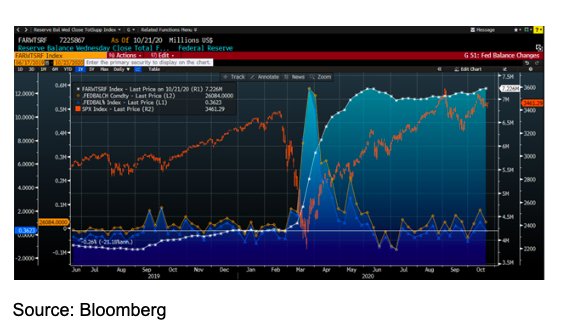We haven’t checked in on the Federal Reserve’s balance sheet for some time. It seems appropriate to take a fresh look after last week’s H.4.1 release.
For the week ending October 21st, the size of the balance sheet was $7.225 trillion, exceeding the prior high of June 10th by a “mere” $8.4 billion. Since bottoming on August 5th, the balance sheet has grown by 3.3%. That doesn’t sound like much, but that reflects a 14.4% annualized pace. The sharp rise in the balance sheet means that the Fed could be showing its concern about the pace and likelihood of fiscal stimulus arriving in the near term.

Consider the following graph, which shows the size of the Federal Reserve Balance Sheet (white) plotted against the S&P 500 Index (SPX, red) and the weekly changes in the balance sheet by absolute amount (orange) and percentage (blue)

Source: Bloomberg
Fed Messaging
In the immediate aftermath of the massive March stimulus, the central bank let its balance sheet shrink by roughly 3% over the rest of June and July. That was widely interpreted as the Fed correcting slightly after overshooting its target, rather than a change to their stated accommodative policies.
The narrative about an accommodative Fed continued even as they allowed the balance sheet to stagnate. The rhetoric from Chairman Powell switched from one of a central bank that was actively adding liquidity to that of one who is vigilant and prepared to add liquidity if that became necessary. That was sufficient for markets that were digesting massive doses of fiscal and monetary stimuli, even as Mr. Powell strongly implied that the next dose of economic medicine should come from the Federal Government, not the Federal Reserve.
Takeaway
Markets are now fixated on the likelihood for a new round of fiscal stimulus. Financial news is dominated by the will they/won’t they negotiations between House Speaker Pelosi and Treasury Secretary Mnuchin.
It is my contention that we are witnessing a daily drama that is being played on behalf of their respective political constituencies rather than working toward legislation that can be enacted as quickly as the markets hope. Bear in mind that any legislation needs approval by the Senate, and Leader McConnell appears unenthusiastic about approving any package prior to Election Day or during a lame duck session.
If I see this obstacle, the Federal Reserve must see this as well. Considering Mr. Powell’s advocacy for a fresh round of fiscal stimulus, we have to believe that he is preparing for what appear to be inevitable delays in its arrival. Markets love fresh money, but it is not clear that the Fed’s recent moves would be sufficient to fully insulate markets against a significant delay in fiscal stimulus.
Photo Credit: Kevin Dooley via Flickr Creative Commons
DISCLOSURE: INTERACTIVE BROKERS
The analysis in this material is provided for information only and is not and should not be construed as an offer to sell or the solicitation of an offer to buy any security. To the extent that this material discusses general market activity, industry or sector trends or other broad-based economic or political conditions, it should not be construed as research or investment advice. To the extent that it includes references to specific securities, commodities, currencies, or other instruments, those references do not constitute a recommendation by IBKR to buy, sell or hold such investments. This material does not and is not intended to take into account the particular financial conditions, investment objectives or requirements of individual customers. Before acting on this material, you should consider whether it is suitable for your particular circumstances and, as necessary, seek professional advice.

